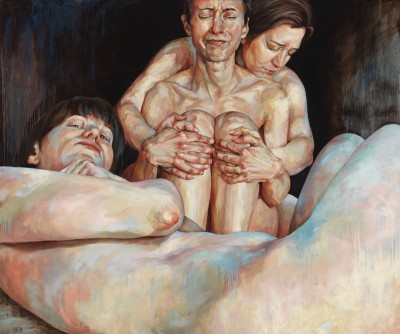The female form is hardly unexplored territory within the history of painting. Nevertheless, when a present-day artist with the sensibility, intuition, and tenderness of Joyce Polance approaches the canvas, the figures in the work do not breathe antiquated. These fleshly women invite us into the mystery of their stories and offer space for us to receive their unspoken pain and healing as part of our own.
Through her work, Polance vulnerably yet confrontationally depicts the emotional curvature of women. She presents images of women as they exist in relationship with one another—as friends, lovers, mothers, sisters, soul-connectors. These glimpses tell us stories, visualizing a form of redemption. In the way her figures seem to touch and interact, she assures us that negative patterns are not the end of the story for women (or men, for that matter) who bear a challenging past. Yet even further, she professes through her work that there are those who can intercede as bodily presences of support when significant figures of the past have failed.
Polance confesses, “Personally, it was a huge surprise to learn as an adult that I could turn to other women I wasn’t biologically related to for something as simple as a hug. That just wasn’t something that was modeled for me. Also, this isn’t meant to exclude men. Many of the women in my paintings represent father and brother figures; I believe men have the same struggles.”
Polance begins her paintings with photo sessions in her studio. She provides her models with a loose sense of how she wants them arranged and then allows for their emotional presence to shape the scene. These sessions inform her paintings’ progressions; the particularities of the photographs find release as texture and painterly layers develop.
The palette is muted, unassuming. It doesn’t get in the way of Polance’s primary concern of exploring the contours of flesh against flesh, bones meeting curves, and the spectacular ordinariness and intricacies of flesh coloring itself. She is not striving to be the next trendiest thing in the art world by juxtaposing conventional figures with psychedelic patterns, obsessive-compulsive drips, or countless other avant-garde convention breakers. These paintings are not neon. Rather, they are ordinary, quiet, and in a sense traditional. Yet they are so smartly composed and executed that viewers don’t have to be at the edges of the contemporary art world to be profoundly impacted. Her work has all of the integrity of the most rigorous discourse, yet as it passes beyond language to a visceral encounter, it seems unconcerned with impressing the overly critical.
The arrangement of the figures and her delicate interplay between light and shadow indicate the psychological complexity of vulnerability, of knowing and being known intimately. The women in her paintings fall into one another, sit atop each other, pull hair, grimace, and weep. Fists clench. Hands hold. “It’s why you’ll often see a juxtaposition of things like tenderness and anger,” says Polance. “It’s never simple.” And such is the reality of our bodies—our lives are a tangle of psychosocial complexities, which like Polance’s paintings often converge in quiet storms of inexpressible physicality, intimacy, and vulnerability.
